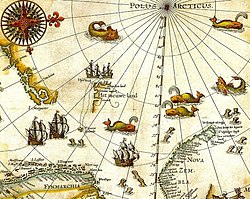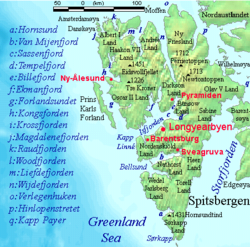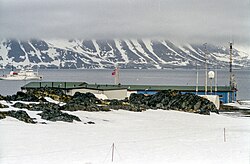Spitsbergen
Spitsbergen (which is also spelled Spitzbergen) is the largest island of the archipelago Svalbard. It was called West Spitsbergen until 1965. The name East Spitsbergen was proposed for the third-largest island of the group, Edgeøya.
| Geography | |
|---|---|
| Location | Arctic Ocean |
| Coordinates | 78°45′N 16°00′E / 78.750°N 16.000°ECoordinates: 78°45′N 16°00′E / 78.750°N 16.000°E |
| Archipelago | Svalbard |
| Area | 37,673 km2 (14,546 sq mi) (36th) |
| Elevation | 1,717 m (5,633 ft) |
| Country | |
Norway | |
| Demographics | |
| Population | 2,642 |
Today, it is the only island on Svalvard which is settled permanently. The island has a size of about 380 kilometres (240 mi) by 220 kilometres (140 mi)
There are only few active settlements on Spitsbergen, among them
- Barentsburg, about 500 people
- Longyearbyen, main settlement, about 2.500 people
- Ny-Ålesund, scientific station, about 30-35 peolple
- Sveagruva,mining town, about 300, many commuting from Longyearbyen
There are several abandoned ones:
- Grumant, mining town, abandoned in 1965
- Colesbukta, shipping terminal for Grumant, about half-way between Grumant and Barentsburg.
- Ny-London, mining town, abandoned in the 1920s. Near Ny-Alesund
- Pyramiden, mining town, mostly abandoned in the 1990s
Spitsbergen Media
Dutch whalers near Spitsbergen by Abraham Storck (1690)
Map detailing the marine features of Spitsbergen in the Svalbard archipelago. Settlements and mountains are indicated and labelled. See also Image:Spitsbergen mountains and marine features labelled.png. Locations were labelled mainly based on detailed maps from svalbard-images.com (sample of south Spitsbergen linked),
A 1906 photograph of the Norwegian whaling factory ship Bucentaur in Bellsund, Spitsbergen
Skottehytta in Petuniabukta, Spitsbergen; polar base of Adam Mickiewicz University in Poznań, Poland
Abandoned mine at Longyearbyen










